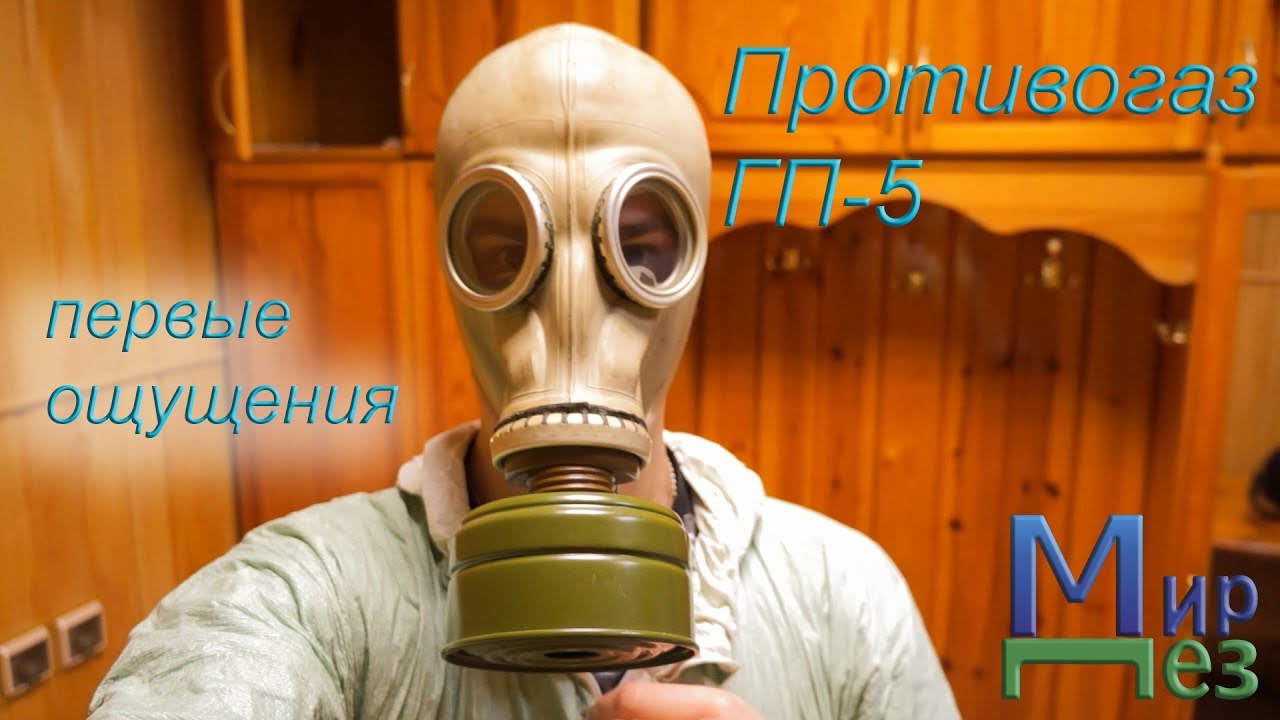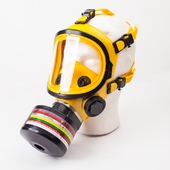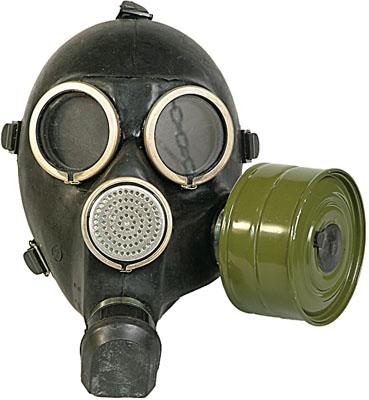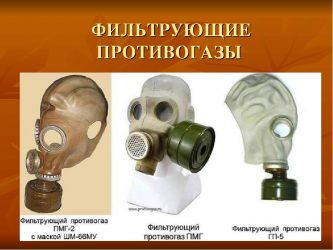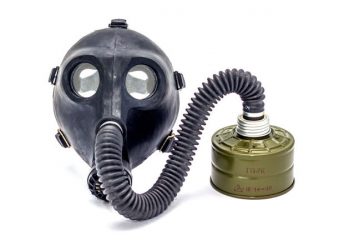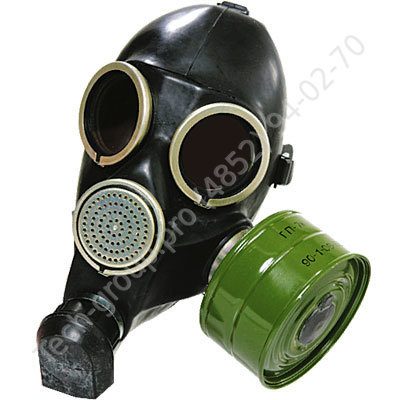Design
The front part of the GP-5 ensures the supply of air purified in a filtering-absorbing box to the respiratory organs and protects the eyes and face from the ingress of poisonous, radioactive substances and bacterial (biological) agents, as well as dust, smoke and fog on them. The front part consists of a rubber body (helmet-mask) with fairings and a spectacle assembly with flat glasses of a round shape, a valve box with inhalation and exhalation valves. It is completed with one-sided films that prevent fogging of the glasses of the spectacle unit, it can also be completed with insulation cuffs that prevent the glasses of the spectacle unit from freezing at negative temperatures.
Front rubber was produced in 5 sizes: 0 (0y), 1 (1y), 2 (2y), 3 (3y), 4 (4y). The letter "y" in a circle next to the number denoting the size of the helmet-mask means that this mask has thinner rubber, which is typical for later batches. The size is indicated by a number on the chin part of the helmet-mask. To select the required height of the helmet-mask, you need to measure the head along a closed line passing through the crown, cheeks and chin. Measurements are rounded to 0.5 cm.When measuring up to 63 cm - 0 height, from 63.5 to 65.5 cm - 1 height, from 66 to 68 cm - 2 height, from 68.5 to 70.5 cm - 3 height, from 71 cm and more - 4 height. On the rubber, the helmet-masks are also molded one under the other markings: the first letter of the city of production and the year, followed by dots indicating the quarter of the year, and the number of the mold (for example: Т86 ... Ф625). The markings could be located both on one and on both sides, and have minor differences in design.
The front valve box serves to distribute the flows of inhaled and exhaled air. An inhalation valve and two exhalation valves (main and additional) are installed inside the valve box. Has a standard 40/4 thread and does not initially have a corrugated tube.
The filtering-absorbing box (FPK) of the GP-5 civilian gas mask has the shape of a cylinder. The FPK body is made of aluminum. In its lower half there is an anti-aerosol filter, and in the upper half there is an absorber (activated carbon). On the lid of the box there is a screwed neck with a standard 40/4 thread for attaching the FPC to the front of the gas mask, and in the bottom there is a round hole through which the inhaled air enters.
The gas mask bag is used to store and carry the gas mask. The gas mask bag is equipped with a shoulder strap with movable buckles for wearing a gas mask over the shoulder and a braid for attaching the gas mask to the torso. The bag has two pockets: a flat one with a partition for placing boxes with anti-fog films and membranes and folding a belt or IPP (individual dressing bag), and the other for an individual IPP-8 anti-chemical bag.
Application
Before use, the civilian gas mask GP-5 must be checked for serviceability and tightness. When examining the face part, you should make sure that the height of the helmet-mask corresponds to the required
Then determine its integrity, paying attention to the glasses of the spectacle assembly. After that, check the valve box, the condition of the valves
They should not be warped, clogged or torn. The filtering-absorbing box should be free of dents, rust, punctures, and damage in the neck. Attention is drawn to the fact that the "grains" of the absorber are not poured into the box. The assembly of the GP-5 civilian gas mask is carried out as follows: the front part is taken in the left hand by the valve box, with the right hand the filter-absorbing box is screwed all the way into the pipe of the valve box of the front part with a screwed neck. Before putting on the new front part of the gas mask, wipe the outside and inside with a clean cloth slightly moistened with water, and blow out the exhalation valves.If any damage is found in the gas mask, they are eliminated; if it is impossible to do this, the gas mask is replaced with a serviceable one. The tested gas mask in assembled form is placed in a bag: the filtering-absorbing box is down, and on top is the front part, which is not bent, only the head and side parts are slightly tucked so as to protect the glass of the spectacle assembly.
A gas mask issued for use can be in 3 positions:
- "Stowed" position,
- ready position,
- "Combat" position.
To bring the civilian gas mask GP-5 to the stowed position, it is necessary to put on a bag with a gas mask over the right shoulder so that it is on the left side, and the fastener is away from you, adjust the shoulder strap with the help of buckles so that the upper edge of the bag is at the level of the waist belt , check the reliability of the gas mask, put the gas mask in the gas mask bag. If necessary, the gas mask can be attached to the belt with a tape. The gas mask is switched to the "ready" position by the "Air Alert" and "Threat of Radioactive Contamination" signals, that is, in the event of an imminent threat of a nuclear, chemical or bacteriological (biological) attack. In this case, it is necessary to move the gas mask forward, unfasten the valve of the gas mask bag, fix the gas mask on the torso with a braid. The gas mask is transferred to the "combat" position by the command "Gases", by the signals "Chemical attack", "Radioactive contamination", "Bacterial contamination", as well as independently (without a command and signals) upon detection of signs of radioactive, toxic substances and bacterial agents air or on the ground.
Box features
The main purpose of the filtering-absorbing box is to purify the air that a person breathes. Gas masks GP-7 are designed to protect the user from poisonous, radioactive and bacterial agents. To create the box, tin or aluminum alloys are used, which are given a cylindrical shape. To keep the body strong, ridges are created on it. Modern gas masks have plastic or metal boxes, each of which is good in its own way. The lightest gas masks are created on the basis of durable plastic - such devices are lightweight and very comfortable and comfortable to wear.
The top cover of the box has a screw-thread neck that connects it to the front. Sealing is ensured by a metal cap and a rubber gasket. At the bottom of the filtering-absorbing box, a hole is thought out through which the inhaled air enters. As an additional equipment, the box has an anti-aerosol filter and a carbon-catalyst (charge). The overall dimensions of the GP-7 gas mask when placed in a bag are 285x210x115 mm.
The aerosol filter includes a plate in the form of a special filter board, which is folded in order to increase the filter surface. The charge is located between two grids, and on top of one of them there is a tampon cardboard - it holds the coal dust.
FPK reliably protects the respiratory system and face from hydrocyanic acid, cyanogen chloride, hydrogen sulfide, chlorine, hydrochloric acid, tetraethyl lead, ethyl mercaptan, nitrobenzene, phenol and furfural.







